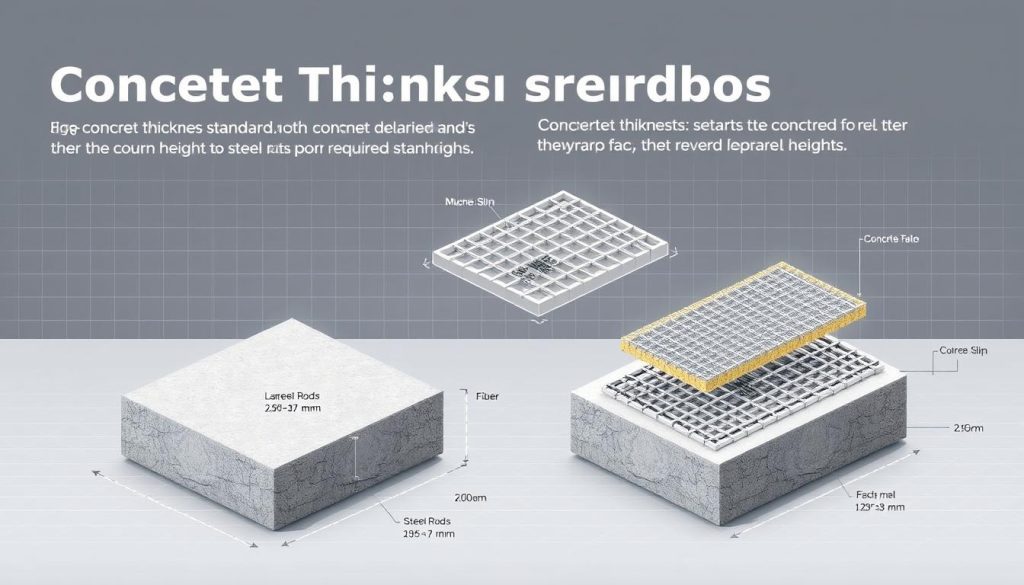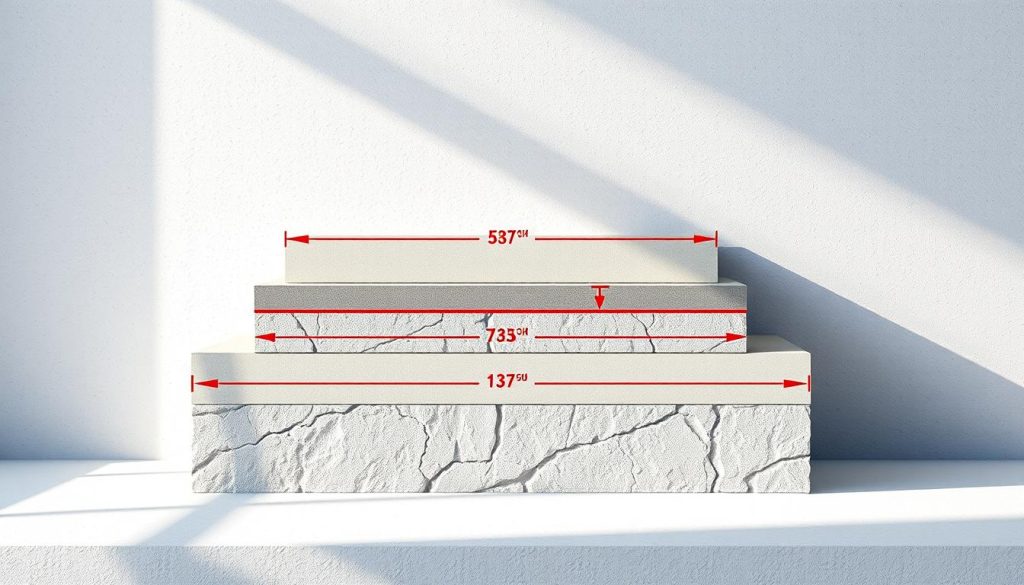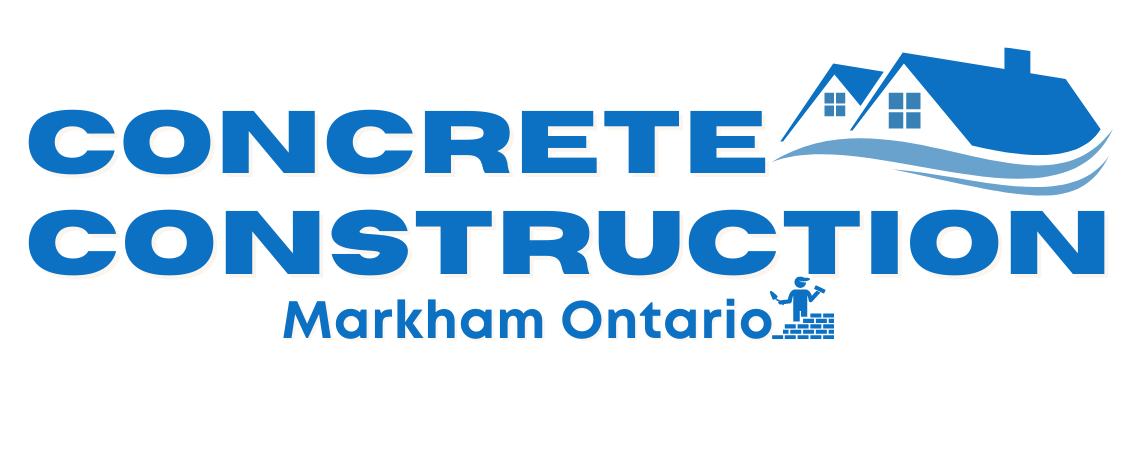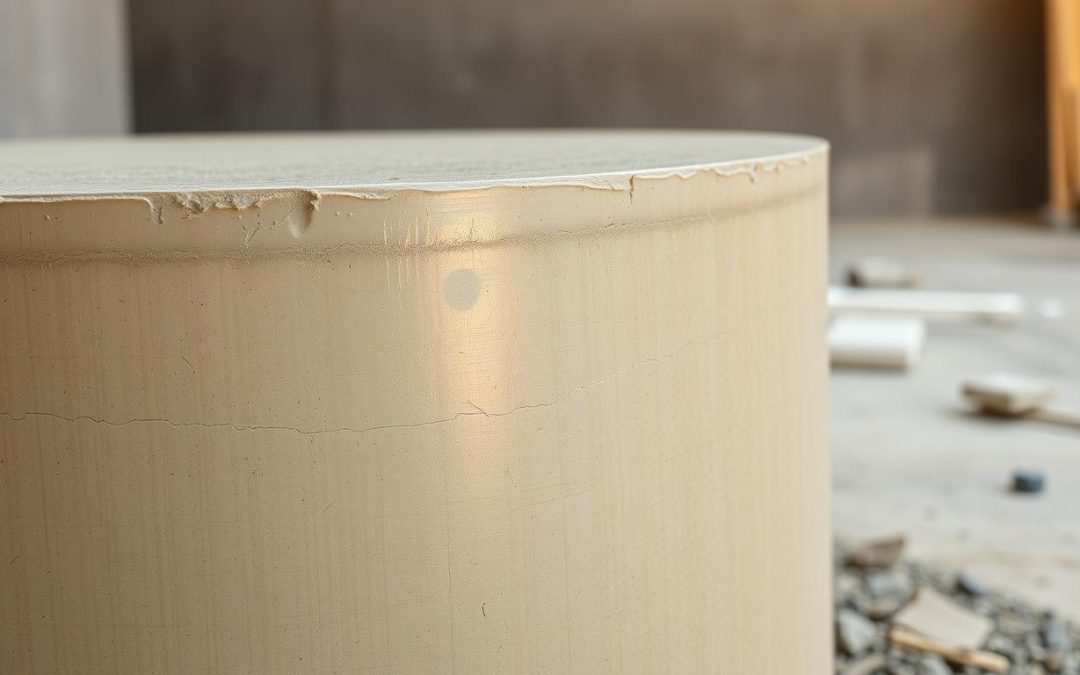When working on concrete projects, knowing the right pour height is key. It ensures the structure is strong and stable. People often ask, “How thick do you usually pour concrete?” The answer varies based on the project type, load-bearing needs, and the environment.
Concrete thickness greatly affects a project’s quality. Whether it’s a driveway, foundation, or sidewalk, the pour height matters. In this article, we’ll cover why thickness is important and how to choose the right pour height for your project. We’ll also look at factors that influence concrete thickness.
Introduction to Concrete Thickness
Knowing what affects concrete thickness helps build lasting projects. We’ll talk about standard thickness needs for various projects. Plus, we’ll share tips to avoid common mistakes.
Key Takeaways
- Concrete thickness is critical for ensuring the durability and stability of a structure.
- Determining the right pour height depends on various factors, including the type of project and environmental conditions.
- Understanding concrete pouring thickness is essential for achieving a strong and long-lasting structure.
- Standard thickness requirements vary depending on the application, such as residential driveways or commercial foundations.
- Avoiding common mistakes, such as under-pouring or over-pouring, is critical for ensuring project quality.
- Getting the right pour height is vital for building a structure that will last for years to come.
Understanding the Basics of Concrete Pouring Depth
Getting the right depth for concrete is key for a structure’s strength and life. The depth of the concrete affects how much weight it can hold, how long it lasts, and how well it works. To find the best depth, you need to think about the soil, weather, and what the structure will be used for.
The concrete thickness standards change based on the project. For example, a driveway at home might need 4 inches, but a business foundation might need 8 inches. Knowing these standards helps make sure the concrete is up to par.
- Soil type and how much weight it can hold
- Weather and climate
- What the structure will be used for
- How much weight it needs to hold
By looking at these factors and following concrete thickness rules, you can make sure your project is strong and meets all the requirements.
How Thick Do You Usually Pour Concrete?
The thickness of concrete is key when pouring it. The recommended concrete pour depth changes based on the structure’s use. For home driveways, 4-6 inches is standard. But, commercial foundations might need 6-8 inches.
To find the ideal depth for concrete pouring, think about the soil and climate. A good rule is to pour concrete based on the structure’s load and stress. You can talk to a pro or use online tools to figure out the right depth for your project.
Here are some common uses and their pour depths:
- Residential driveways: 4-6 inches
- Commercial foundations: 6-8 inches
Knowing what affects the ideal depth for concrete pouring helps. Following the recommended concrete pour depth ensures a strong, lasting concrete structure. It meets your needs and lasts for years.
Standard Thickness Requirements for Different Applications
The thickness of a concrete slab is key for its strength and performance. Each use has its own standard thickness needs. Knowing these guidelines is vital for a project’s success. The pouring concrete thickness guidelines change based on the slab’s purpose.
For example, driveways in homes usually need a 4-inch slab. But, commercial foundations might need 6-8 inches. This is because commercial areas handle heavier loads and stress.
- Residential driveways: 4 inches
- Commercial foundations: 6-8 inches
- Sidewalks and pathways: 4-6 inches
- Garage floors: 6-8 inches
It’s important to stick to thesepouring concrete thickness guidelines. This way, your slab can handle the load and last longer.
Essential Tools for Measuring Concrete Thickness
Measuring concrete thickness is key to getting the pour depth right. To do this, the right tools are needed. Best practices for concrete pouring depth mix old methods with new tech. Tools like slump tests, concrete gauges, and ultrasonic meters are common.
These tools help check the concrete’s thickness. This is vital for a building’s strength. By following best practices for concrete pouring depth, mistakes are avoided. This saves money and prevents damage.
Choosing the right tool is important for accurate measurements. Consider these factors:
- Type of concrete: Different concretes need different tools.
- Pour depth: The pour’s depth decides the tool needed.
- Surface finish: The surface finish affects the tool choice.
Using the right tools and best practices for concrete pouring depth ensures quality pours. This saves time and money. It also makes the structure safe and durable.
Climate and Environmental Factors in Pour Depth
When figuring out the best concrete pouring depth, climate and environment matter a lot. The concrete pouring thickness needed can change a lot based on weather and moisture. It’s key to think about these things to get strong and lasting concrete.
The optimal concrete pouring depth can change with cold weather, hot climates, and moisture. For example, in cold weather, you might need a deeper pour to handle freezing. But in hot places, a shallower pour helps avoid too much heat. Knowing these things helps pick the right pour depth for your project.
- Cold weather: needs a deeper pour to handle freezing
- Hot climates: needs a shallower pour to avoid too much heat
- Moisture levels: high moisture can make concrete weaker, so you might need to adjust the pour depth
By considering these factors and adjusting the concrete pouring thickness and optimal concrete pouring depth as needed, you can make sure your concrete is strong and lasts. This is true whether you’re working on a home driveway or a big commercial foundation. Always think about climate and environment for a project that works well.
Reinforcement Methods and Their Effect on Thickness
Reinforcement methods are key when figuring out the recommended concrete pour depth. The type and amount of reinforcement greatly affect a concrete structure’s strength and durability. It’s important to consider concrete thickness standards along with the chosen reinforcement method for a strong structure.
Reinforcement, like rebar or fiber mesh, can change how thick the concrete needs to be. For example, a structure needing to hold a lot of weight might need thicker concrete. This is why concrete thickness standards are so important to get right.
Here are some common reinforcement methods and how they affect concrete thickness:
- Rebar: Increases load-bearing capacity, may require thicker concrete pour
- Fiber mesh: Enhances durability, can reduce concrete pour depth
- Wire mesh: Provides added strength, may require thicker concrete pour

Knowing how reinforcement methods impact recommended concrete pour depth helps builders and contractors make better choices. It’s vital to look at concrete thickness standards and the specific reinforcement method used. This ensures a successful and durable structure.
Common Mistakes to Avoid When Determining Pour Depth
When figuring out the right pour depth for your concrete project, many mistakes can happen. Knowing how thick to pour concrete is key to a successful project. Following concrete pouring thickness guidelines helps avoid these errors. Getting the thickness just right is critical.
To pour perfectly, you must follow the concrete pouring thickness guidelines. These guidelines help you find the perfect thickness for your project. They consider load-bearing capacity and environmental conditions. By following these, your concrete project will be strong and last long.
Common mistakes include under-pouring, over-pouring, and uneven thickness. These can cause structural weaknesses and uneven surfaces. To avoid these, plan and execute your pour carefully, considering your project’s needs.
Under-Pouring Issues
Under-pouring can cause structural weaknesses and uneven surfaces. To avoid it, calculate the concrete’s thickness carefully. Consider load-bearing capacity and environmental conditions.
Over-Pouring Problems
Over-pouring can waste materials and increase costs. To avoid it, plan and execute your pour carefully. Consider your project’s specific needs.
Inconsistent Thickness Challenges
Inconsistent thickness can cause uneven surfaces and structural weaknesses. To avoid it, monitor the pouring process closely. Ensure the concrete is poured to the correct thickness throughout.
Cost Implications of Different Concrete Thicknesses
The cost of concrete projects changes with the pour depth. Thicker pours need more materials and labor, raising the project cost. Thinner pours might not hold weight, causing structural problems and extra maintenance costs. Finding the right balance between cost and depth is key.
The cost of materials is a big factor in concrete projects. Material calculations are vital for estimating costs. For example, thicker pours require more cement and aggregate, raising material costs.
Labor costs also play a role. The time and effort to pour and finish concrete vary with depth and project complexity. More complex or thicker projects need more labor, increasing costs. Choosing the right depth can help keep costs down and ensure a smooth project.

- Material costs: The type and amount of materials affect the project’s cost.
- Labor costs: The time and effort needed to pour and finish concrete change with depth and complexity.
- Optimal concrete pouring depth: Picking the right depth can save costs and ensure a successful project.
Conclusion: Making the Right Choice for Your Concrete Project
As we conclude this guide, it’s clear that choosing the right pour height for your concrete project is key. Understanding how thick to pour concrete and following best practices are vital. This ensures your project is durable and meets standards.
Think about what your project needs. Is it a driveway, foundation, or sidewalk? Check local building codes and talk to experts. They can help you figure out the best thickness for your project.
Choosing the right pour depth for your concrete project is all about careful planning. By following our guidelines, you can pour concrete that lasts for years. This will give you a solid foundation for the future.

